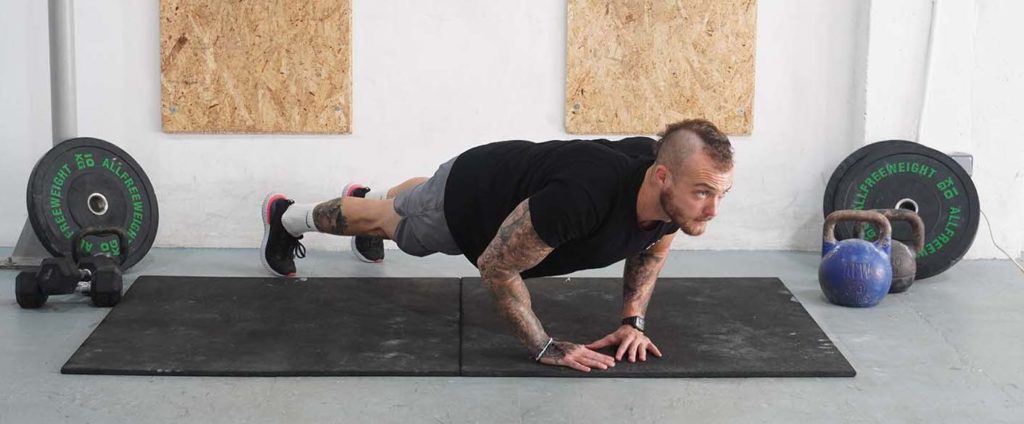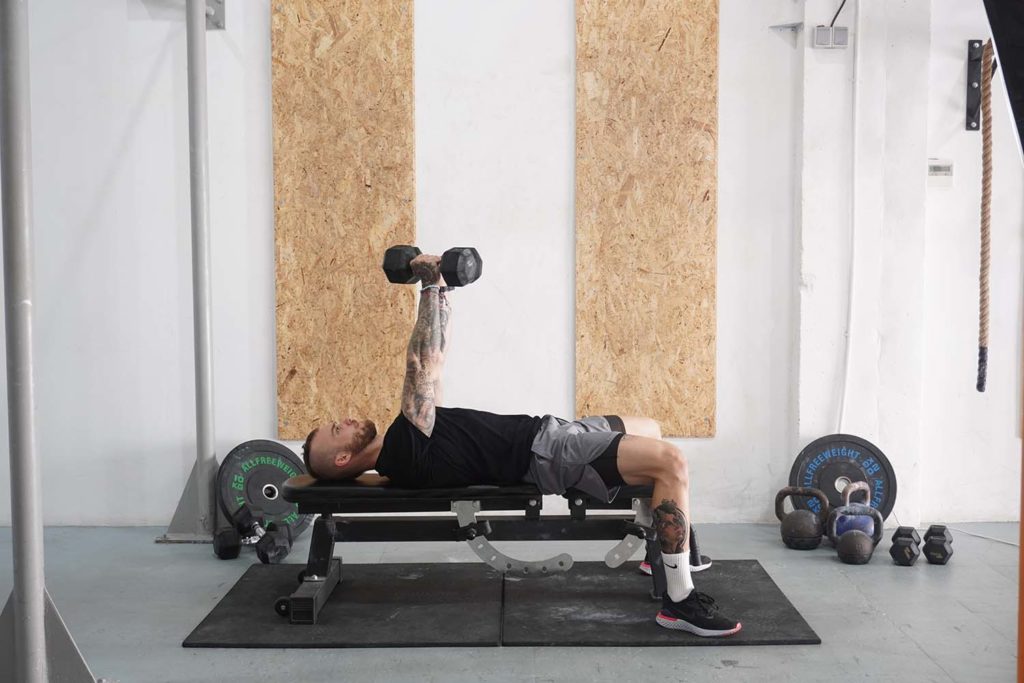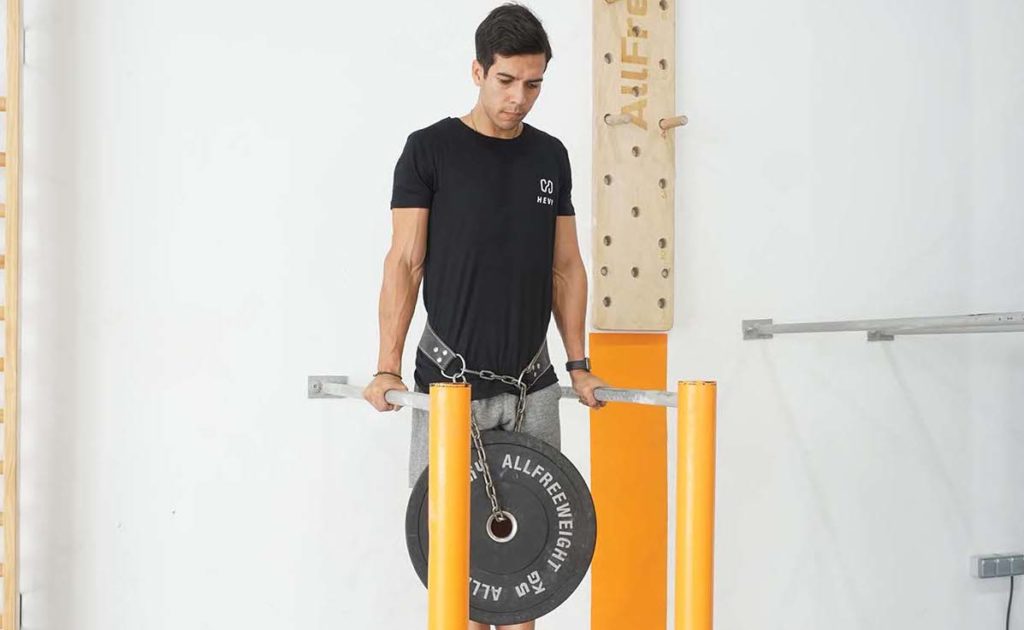Get Strong Arms with Weighted Pushups
Weighted push-ups are an effective exercise that strengthens and develops the chest, shoulders, and triceps. The movement is similar to regular push-ups, with the only difference being the external load you place on yourself to induce a more significant overload.
There are several options for the weighted push-up, the most popular being to assume the position and have someone place one or more weight plates on your mid-back. A more practical solution is to put a weighted vest on yourself. Doing so would force you to press more weight, build strength, and develop your muscles.
Working up to a weighted push-up takes time. The simplest option is to improve your performance on the bodyweight exercise by starting with knee push-ups. Over time, you can transition to classic push-ups and diamond push-ups. Decline and plyometric push-ups would be the next step. Once you’re reasonably strong and can do at least 30 reps without breaking a sweat, begin experimenting with additional weight.
Alternatively, focus on traditional push exercises, including the bench press, incline press, chest dip, and overhead press. Combine these exercises with the close-grip press, skullcrushers, and triceps dips to develop your triceps. Focus on making small but consistent strength gains, and you will develop the necessary capacity for weighted push-ups.
We recommend including the weighted push-up early in your workouts, preferably first or second. For example, start your push workout with several sets of weighted push-ups and move on to other exercises like the bench press, fly, lateral raise, and such. You can perform straight sets (using the same extra load from start to finish) or pyramid your way up with each new set. For instance, start with 10 lbs on the first set and gradually work up to 45 or 55 lbs by the fourth or fifth set.
Level of the exercise: Advanced
Benefits of the Weighted Pushup
1. A Fantastic Overloading Potential
Traditional push-ups are a great exercise, but their main drawback is the lack of good overload. Your main option as you get stronger is to do more repetitions, and trainees often work up to 40, 50, even 60 reps per set. Doing so makes for less practical training that takes longer to cause an adequate growth stimulus. Plus, having to do excessively high-rep sets can lead to stress on your joints and connective tissues, increasing your risk of cumulative injuries.
Weighted pushups are fantastic precisely because you can keep adding weight to remain in a specific repetition range (say, between 8 and 15 reps). As a result, you can use the exercise for a long time to build upper body strength, core stability, and muscle mass.
2. Good For Shoulder Health
Though many people see the push-up and the bench press as identical exercises, there is one crucial difference between the two. All push-up variations allow for free scapular movement, which is vital for developing the serratus anterior––the boxer’s muscle. The serratus covers the upper lateral part of the ribcage, produces shoulder protraction, and promotes scapular stability (1).
Performing the push-up (including weighted variations) is beneficial for shoulder health because these movements strengthen the serratus. As a result, our shoulders remain safe, and we are at a lower risk of impingement, especially during overhead pressing.
3. Weighted Pushups Are Practical
Overhead presses, bench presses, flyes, and other similar movements are great, but they come with one drawback:
You need special equipment to do them, which isn’t necessarily alarming if you have regular gym access, but it can be troublesome for folks who have to train at home. Plus, gym crowds can often make it challenging to secure a bench or cable machine.
A fantastic benefit of the weighted push-up is the movement’s practicality. All you need is a bit of free space and a weight plate. Alternatively, investing in a weighted vest can make the experience even more practical, allowing you to adjust the resistance as you see fit.
How to do Weighted Pushups
- Get down on your knees and hands.
- Straighten your legs to support your lower body on your toes and have your feet at a hip-width distance.
- Position your hands slightly wider than shoulder-level apart and keep your elbows tucked to prevent shoulder issues.
- Engage your abs to ensure a neutral spine position.
- Have someone place a weight plate on your mid-back. Alternatively, place the weight on your back before extending your body in the push-up position. The third option is to put a weighted vest on yourself before getting down on the floor.
- Take a breath and lower yourself by bending your elbows.
- Go down as much as your strength allows––ideally until your torso is a couple of inches from the floor.
- Hold the bottom position for a moment and press yourself to the top, extending your elbows, and exhaling.
- Take another breath and repeat.
What muscle groups do weighted pushups activate?
Weighted push-ups train multiple muscle groups, the primary of which is the pectoralis major, which covers the front upper half of the torso (2, 3). Both pectoral heads insert into the humerus (upper arm bone) and play a role in numerous arm and shoulder motions. In the case of the push-up, the pectorals contact, allowing us to press ourselves away from the floor.
Our deltoids (shoulders) also play a role during weighted push-ups (4). The muscle group provides stability at the shoulder joint, and the front deltoid head assists the pecs on each repetition.
The triceps is another muscle group with an active role during weighted push-ups. Our triceps cover the rear of the upper arms and produce elbow extension, which occurs as we press ourselves off the bottom (2, 5).
Aside from the three major muscles, the serratus anterior contributes to shoulder stability and protraction. The muscle covers the upper lateral region of the ribcage and inserts into the scapula, allowing it to influence our shoulders and upper back (1).
The midsection musculature (abs, transverse abdominis, obliques, erector spinae, and glutes) is static during weighted push-ups. These muscles flex isometrically, providing torso stability and keeping us stable.
The Difference between the Weighted Pushup and Bench Press
At first glance, weighted push-ups and the bench press might seem the same, but there are slight differences that determine each movement’s impact on your upper body.
The most notable difference between weighted push-ups and the bench press is the scapular range of motion. Push-ups allow you to maintain some scapular movement, which can be good for shoulder health and serratus anterior activation. In contrast, bench pressing is about pinning your shoulder blades to the bench to create upper back stability. As such, there is much less scapular activity.
A similarity between the two exercises is the overall movement pattern. The same muscles work, and you’re training through identical ranges of motion (6). Another similarity between the two exercises is the overloading potential. While overloading push-ups might be more challenging, you can increase the resistance level as you get stronger and use the exercise to develop your upper body for many years.
A significant benefit of push-ups is that the movement is safer, and there is no risk of hurting yourself if you fail a repetition. On the other hand, failing to press the weight away from yourself can cause you to get pinned underneath and bruise your chest.
Variations and Modifications of the Weighted Push-Up
1. Weighted Diamond Push-Up

Diamond push-ups are an effective variation where the objective is to have your hands close to one another. Doing so emphasizes your triceps, and the additional resistance leads to a better overload (2).
2. Resistance Band Push-Up
The resistance band push-up is a neat variation you can leverage if you’re looking to switch things up. Instead of using a weight plate or weighted vest, you have to wrap a looped band over your hands and behind your back. Doing so provides you with extra resistance, especially as you reach the top of each push-up repetition.
3. Elevated Weighted Push-Up
The elevated weighted push-up is a variation you perform by elevating your hands and feet on a pair of identical boxes. Instead of using a weight vest or plate, you attach a weight to yourself via a weight belt and have it hang from your midsection.
Mistakes to Avoid
Not Using a Full Range of Motion
A common mistake with weighted push-ups is shortening the range of motion. Many eager trainees rush into weighted push-ups but lack the necessary strength to do complete reps and instead lower themselves halfway down. Doing so defeats the purpose of the movement because you’re making each repetition easier and less effective. Lower yourself until your torso is close to the floor or stick to bodyweight push-ups.
Attempting Weighed Push-Ups too Soon
Another mistake of weighted push-ups is doing the exercise too soon, which is unnecessary because you can use plenty of practical activities to progress. We recommend working up to at least 30 bodyweight reps in a row before introducing any external weight.
Flaring Your Elbows
Flaring your elbows is another mistake to avoid with any kind of push-up. Doing so puts your shoulders in a weaker and more compromised position, increasing the risk of impingement. Avoid the error by keeping your elbows somewhat tucked in and your shoulder blades retracted.
Similar Exercises to the Weighted Push-Up
Bench Press (Dumbbell)

The dumbbell bench press is an effective compound exercise that strengthens the same muscles as a push-up (6). Using dumbbells is beneficial because it allows you to train both sides of your body independently, reducing the risk of side-to-side muscle or strength imbalances.
Chest Dip (Weighted)

Similar to the weighted push-up, weighted dips are a fantastic exercise that strengthens your pectoralis major, triceps, and deltoids. The movement is also beneficial for your core, back, and serratus anterior. Plus, the overloading potential is excellent, and you can use the exercise to build muscle and get stronger for a long time.

